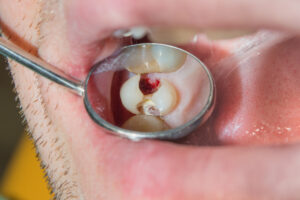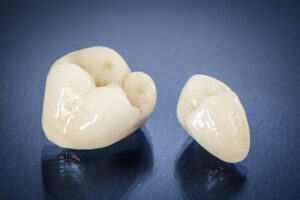Why Do I Need a Crown?
By now, you’ve probably seen the cute meme that says, “My dentist said I need a crown. I was like, I know, right?!?” While we don’t need to know why you deserve that kind of crown, we want to make sure you understand why you need this kind of crown.
A dental crown, or “cap” as some people call it, is an important treatment that restores a tooth to its natural shape and function. The reason a tooth needs a crown is that, somehow, it has lost its natural shape or ability to function properly. This loss can occur in many different ways, which is what we will explain in this article.
A Large Cavity
When a tooth suffers from extensive decay, the “cavity” destroys the natural hard tooth structure, leaving a physical hole in the tooth. Because cavities are progressive, it is essential that you stop the decay from continuing to grow. Stopping the decay isn’t enough, though. You have to rebuild what has been lost in order to restore that tooth back to normal function.
When decay destroys a large majority of the tooth’s natural hard structure, a filling is not strong enough to support chewing forces. A crown is necessary to cover and protect the underlying tooth structure, enabling the tooth to function properly for many years.
Cracked Tooth
 A healthy tooth consists of a hollow chamber of nerves and blood vessels, surrounded by a core of dentin (hard tooth structure that is slightly yellow and porous) and covered by a protective layer of enamel. Enamel is the hardest structure in the human body. When a tooth forms, it begins with the enamel layer, creating it as a single, continuous structure. In a healthy tooth, enamel maintains that unbroken coating, protecting the tooth against the normal forces of eating and drinking.
A healthy tooth consists of a hollow chamber of nerves and blood vessels, surrounded by a core of dentin (hard tooth structure that is slightly yellow and porous) and covered by a protective layer of enamel. Enamel is the hardest structure in the human body. When a tooth forms, it begins with the enamel layer, creating it as a single, continuous structure. In a healthy tooth, enamel maintains that unbroken coating, protecting the tooth against the normal forces of eating and drinking.
When enamel cracks, it cannot repair itself. The crack allows bacteria and the sensations of hot and cold to penetrate the internal chamber of the tooth. Cracked teeth must be covered with a crown, which acts as an enamel replacement. A new, unbroken crown replaces the enamel and takes on its role for covering and protecting the underlying tooth structure.
Root Canal Treatment
A root canal treatment is necessary to “fix” a tooth with an infected or dead nerve chamber. No matter the cause of the nerve problem (whether decay or injury), the solution is the same: to remove the nerve and blood vessel tissues from within the tooth and replace them with a biocompatible filling. This is the only way to save the tooth.
One of the consequences of root canal treatment on a tooth is a high risk for fracturing. This is because the root canal not only removes the nerves from the internal chamber, but also the blood vessels, which provide hydration to the tooth. Without this hydration, the tooth dries out and becomes brittle. In almost every case, a crown is necessary to cover a tooth that has had a root canal in order to prevent cracking.
Failing Dental Work
This category includes both old fillings and old crowns. We will break it up and discuss each one individually as the reason for the necessity of a crown is different.
Failing Fillings
When an old filling begins to break down, it no longer serves its purpose of sealing out bacteria and enabling good chewing function. As we evaluate old dental work, we assess how much natural tooth structure will remain after removing the old material and any underlying decay. There are many cases in which there is not enough healthy tooth structure leftover to support a replacement filling. Instead of replacing the old filling with a new one, we must cover the tooth with a crown.
This happens frequently when there is an existing large filling in a tooth that has new decay or a new fracture line. By the time we get the old filling out and remove anything that is not healthy tooth structure, there is very little remaining to “hold” a new filling.
Failing Crowns
Perhaps this goes without saying. If an old crown fails, you need a new crown. By “failing”, we mean that it no longer seals out bacteria, fills the space of the natural tooth, and helps you properly chew your food. If there is an opening between the crown and the tooth, bacteria can penetrate underneath the crown and cause new decay. If the crown breaks, and you begin to have food impaction between the teeth or no longer have biting contact with the opposite tooth, you need to replace it.
What Makes a Crown Successful?
 The reasons for a tooth needing a crown are many and varying in nature. Dental crowns are predictable and successful in the long term. There are two important ingredients in the success of dental crowns. Dr. Ann is responsible for one, and you are responsible for the other.
The reasons for a tooth needing a crown are many and varying in nature. Dental crowns are predictable and successful in the long term. There are two important ingredients in the success of dental crowns. Dr. Ann is responsible for one, and you are responsible for the other.
- Excellent Dental Technique – For a crown to last for decades, your dentist must perform excellent work. The specifications of the preparation of the tooth, the quality of the lab technician, and the confirmation of perfect fit are all in your dentist’s hands. At Designer Smiles, we have always produced the highest quality dental care, and we remain committed to continue doing so.
- Excellent Home Care – Once the beautifully made crown is on your tooth, the responsibility for success becomes yours. Crowns can get new cavities, so practicing great oral hygiene to remove dental plaque is essential. You must not assume that because the tooth has a crown, it’s “good”. The margin, or edge where the crown meets the tooth, has a high risk for cavity formation. If you have trouble controlling plaque around your crowns, talk to Phyllis and Nancy about the problems you’re having. They can provide instructions, tips, and accessories for the best plaque removal.
More Questions about Crowns?
Call Designer Smiles today to schedule a consultation with Dr. Ann. She can answer any question you have about why you need a crown or simply about crowns in general. Our team is here to help you!
